Warszawa II (8 page)
Authors: Norbert Bacyk

On July 30, the situation was complicated even more on the stretch towards Warsaw. Early that morning, the 3rd Tank Corps' reconnaissance units tried to seize Zielonka. The Germans beat off the assault. At the same time, the corps' main force struck at WoÅomin and after they had taken it, they set their sights on Radzymin. After a couple of hours, both towns were in General Vjedjenjev's hands. Frontline troops within the 103rd Tank Brigade had encircled Radzymin â the 50th Tank Brigade had occupied positions west of WoÅomin in the area by the road towards Marki, while the 51st Tank Brigade had secured the corps' right flank, east of StanisÅawów. Additional forces, in the form of the 57th Mechanised Brigade, were also on their way to this area, although they had for a short period of time lost connection with their tank units during an attack against German corps' second echelon. Here, it's appropriate to point out that in carrying out this well-executed armoured raid into unknown territory, the Soviet tank crews were indebted to local units of the Home Army and the local population, who had gladly volunteered their expert knowledge of the area.
The seizure of Radzymin by the 103rd Tank Brigade meant that the 3rd Tank Corps â commander had, in effect, executed the order to cut off the German 9th Army from the 2nd Army. Meanwhile, the 8th Tank Guards Corps, which found itself in back of the 3rd Tank Corps, went round MiÅsk Mazowiecki in a westerly direction. The corps' frontline troops had reached the area east of Okuniew. The 16th Tank Corps, which attacked from the Otwock area, having identified the enemy's defensive status, continued the offensive towards Praga. On July 30, under increased resistance from the 73rd Infantry-Division, the Soviets seized Åwider, Józefów and WiÄ
zowna. The main road to Warsaw from the south passed through WiÄ
zowna. From here, Soviet units carried out a raid outside the ZakrÄt district where the main roads from Siedlce and Lublin met. The capture of this village created a threat that the combating German units would be outflanked outside of Falencia.
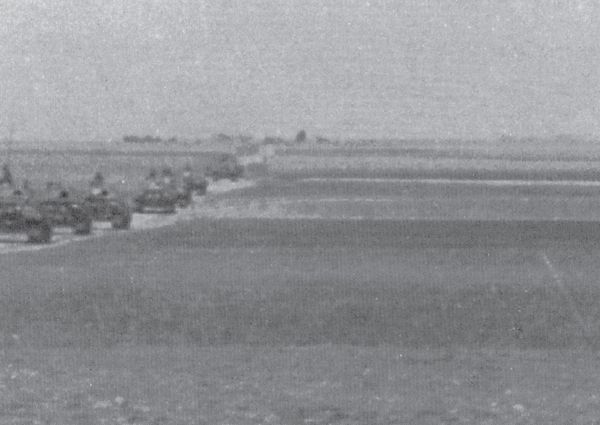
A tank column of PzKpfw V “Panthers” from the 3rd SS-Panzer-Division “Totenkopf” or from the 5th SS- Panzer- Division “Wiking”, on their way to the front, July â August 1944. (CAW)
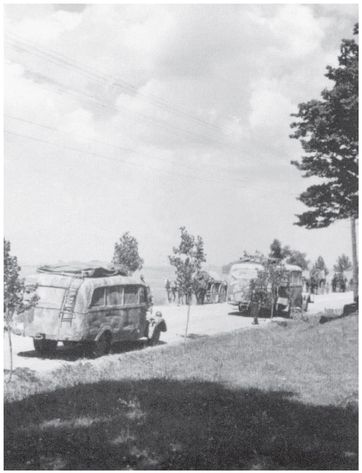
Headquarter troops from the 4th Panzer-Division during a march east of Warsaw, July 1944. (Leandoer & Ekholm Archive)
Assessing the situation that had arisen, the command staff of the 9th Army decided to immediately launch a counter-attack, but the XXXIX Panzer-Corps at this juncture commanded only the incomplete Division “Herman Göring “ plus a weak Kampfgruppe drawn from the 19th Panzer-Division. But the Germans had a bit of luck â part of which lay in the fact that on July 30 the greater part of the tanks belonging to the Fallscirm-Panzer-Regiment “Herman Göring” had already been off-loaded from the transporting freight trains â and partly in that there had been enough time to complete the consolidation of reinforcements with the 1st Grenadier Regiment, outside of Marki. At the same time, tanks from Panzer-Regiment 27 and the 19th Panzer-Division were en route from the direction of Wyszków. Moreover, PzKpfw IVs from the II Fallschirm-Panzer-Regiment “Herman Göring” sped through Warsaw, and thereafter were able to reinforce the Kampfgruppe from its own “mother” unit.
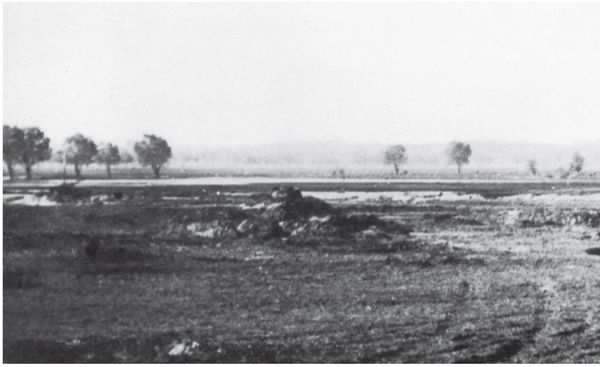
On July 30, the XXXIX Panzer-Corps launched a counter-offensive. Augmented with tanks and artillery, a Kampfgruppe from Fallschirm-Pz.Gren. Rgt. 1 “Herman Göring” attacked in the direction of WoÅomin from the area around Marki. Another unit from the 19th Panzer-Division (II Pz.Gren. Rgt. 74, a Tank company from the II Pz.Rgt. 27 and the II Battery in the 19th Panzer-Artillery-Regiment), together with infantry from the 73rd Infantry-Division, conducted an attack on the village of ZakrÄt. Northeast of Radzymin, fighting also broke out when the 103rd Tank Brigade and advance forces from the 19th Panzer-Division clashed. The German attack was by no means overwhelming because it was carried out by fairly reduced forces: Both the 19th Panzer-Division and the “Herman Göring,” neither of which had yet completed their respective consolidations, engaged only solitary regiments in battle. An additional two Waffen-SS tank divisions were unable to participate in the fighting during the course of the day. Columns out of the 3rd SS-Panzer-Division “Totenkopf ” were just leaving Siedlce and didn't reach Chojeczno, halfway between Siedlce and KaÅuszyn, until that evening. Soldiers in the 5th SS-Panzer-Division “Wiking” were also on their way toward KaÅuszyn.
The German attack from the direction of Praga, made General Radzjijevskij abundantly aware that the enemy still had the means to execute telling combat operations on his army's left flank. Units from the 16th Tank Corps were transported from the area around ZakrÄt and withdrew to WiÄ
zowna. Thereafter, the 3rd Tank Corps threw back the attack against WoÅomin, as well as the attack against Radzymin, but was then forced to defend itself. General Vjedjenjejev reacted very quickly to the changed situation. He gave orders to, among other things, set about organizing an indirect defence; firing trenches must be dug for a number of tanks, anti-tank ambushes must be prepared making use of anti-tank guns, the corps' artillery must be called in and reserve units created. With over 150 tanks and tracked artillery vehicles, the 3rd Tank Corps hardly represented an insignificant force. According to Soviet combat calculations, the 2nd Tank Army's first echelon-corps would remain in a defensive posture until it established broad contact with 8th Tank Guards Corps and the 16th Tank Corps. At the same time, General Radzjijevskij reported to General Rokossovskij informing him about the increasingly strong German resistance in Praga's outlying towns and requested additional heavy artillery units to break it down. Rokossovskij responded that he, General Radzjijevskij, should concentrate on cutting off the German 9th Army from its 2nd Army, and hand over the mission of seizing the city to the 47th Army which was en route as part of the second echelon. In theory, Radzjijevskij had command of forces capable of carrying out this order. However, between July 18 and July 30, 1944, the 2nd Tank Army suffered a total loss of 582 soldiers killed in action, 1,581 wounded and an additional 52 soldiers unaccounted for, along with the loss of approximately 130 tanks and tracked artillery guns. Still, given such a large fighting force, these losses were not all that serious â and the army had potential access to a further 560 to 680 armoured vehicles.
A battlefield in Eastern Poland towards the end of July 1944. In the picture, starting from the left can be seen a T-34-85, a JSII and a PzKpfw IV ausf H. The picture was taken by a German camera which probably indicates that the Red Army was the loser in this engagement. (Leandoer & Ekholm)
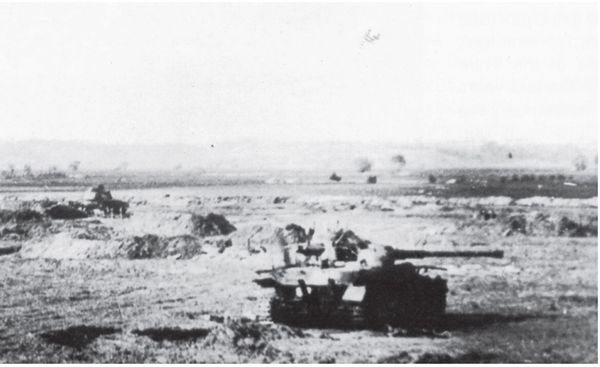
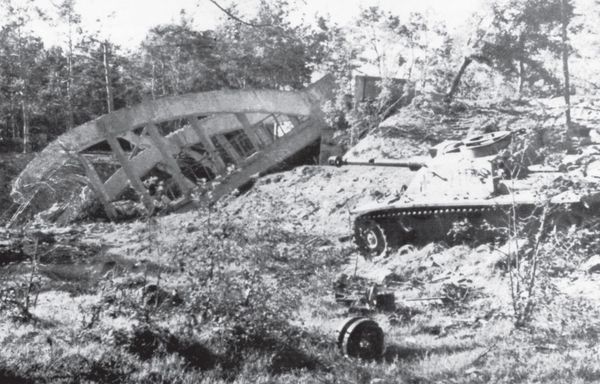
A blown up bridge and a blown up StuG III ausf G.the former will (Leandoer & Ekholm Archive)
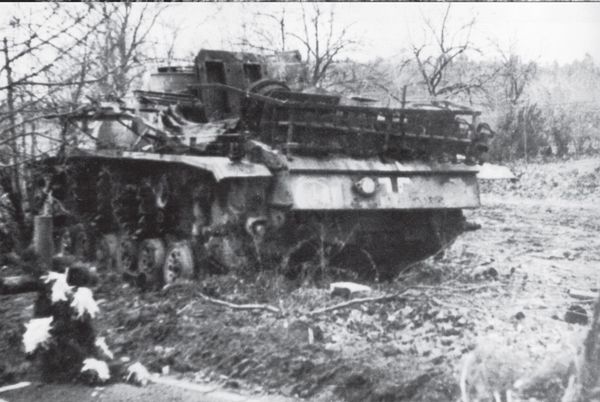
A knocked out StuG III ausf G with a recently dug German grave behind the tank. The spot is on the borderland between Belorussia and Poland, July 1944. (Leandoer & Ekholm Archive)
On July 31, just as additional units arrived from Division “Herman Goring,” the Germans increased their pressure on the 3rd Tank Army's left flank. From the direction of Praga, attacks were mounted along the Marki â Radzymin motorway, as well as along the Zielonka â WoÅomin railway line. The 19th Panzer-Division's main combat force, in the meantime, approached Radzymin from the northeast. Despite the German XXXIX Panzer-Corps (now called: Gruppe “von Saucken”) having taken over the initiative, it was still numerically significantly weaker than the Soviet 2nd Tank Army and, in terms of frontline troops, it was even weaker than the 3rd Tank Corps. During the day, the last Pzkpfw IV from the II Fallschirm-Panzer-Regiment “Herman Göring” finally linked up with the troops already engaged in combat (the off-loading of the whole division was completed on August 4). Thanks to the above-cited unequal numerical strength and the competent defence put up by the Soviets, all German counter-attacks were beaten back with bloody results. General von Saucken was thus very impatiently awaiting the arrival of the two promised Waffen-SS-Divisions and the 4th Panzer-Division (which he had earlier commanded) to spearhead his attack. During the last day of July, the reinforced SS-Panzergrenadier-Regiment 9 “Germania” arrived, along with a portion of the 3rd SS-Panzer-Division “Totenkopf” in the area around StanisÅawów â but Kampfgruppe “Westland” from the 5th SS-Panzer-Division “Wiking” was still engaged in crossing over the Bug north of WÄgrów. Nor was SS-Oberführer Becker's unit in a position to engage in battle at full strength, since the 3rd SS-Panzer-Division “Totenkopf ” was still fighting in the Siedlce region. Despite this, after having received a report that a Kampfgruppe drawn from both forces would possibly begin to participate in the fighting the following day, he contacted the commander of the XXXIX Panzer-Corps, SS Gruppenführer Gille, for the purpose of coordinating all the divisions' operations. General von Saucken also received a report to the effect that the 4th Panzer-Division forces were en route in the direction of Wyszlów. However, because of rain and the length of the division's transport, they could not join the fighting for an additional 48 hours.
